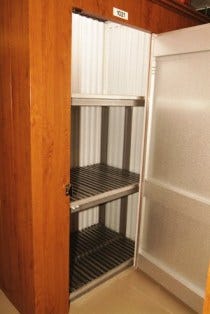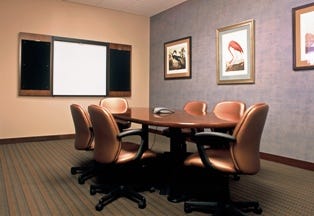Adding Wine Storage to a Self-Storage Business: Marketing, Design and Legal Considerations
Traditional self-storage and wine storage have proven to be a good marriage, and the basic self-storage operational design caters to wine storage with little additional personnel services or operating expenses. However, special attention must be paid to product feasibility, design and legal considerations to ensure an operators success in this niche market.
May 7, 2012
By Jim Ponti
This year marks 18 years of consecutive growth for wine consumption in the United States, so its no wonder wine storage has become a hot commodity. Like the wine industry, self-storage has evolved in many ways over the years. Not only are the details, designs, operation and aesthetics more calculated, the services being offered by many facilities have expanded.
In many affluent urban markets, self-storage facilities have either added wine storage or included it within their original construction design. Traditional self-storage and wine storage have proven to be a good marriage, and the basic self-storage operational design caters to wine storage with little additional personnel services or operating expenses. If you're interested in combining wine storage with your existing or future self-storage development, consider the following important aspects: market feasibility, facility design and legal considerations.
Determining Your Target Market
There are mainly two reasons for the inclusion of wine storage in a traditional self-storage facility. First, the monthly revenue per square foot of floor area can be exponentially higher than typical climate-controlled storage. Second, it broadens the market appeal and quality perception of a facility while bringing another market segment through the doors. Both are great reasons to consider wine storage, providing your facility is in this specific demographic landscape.
While there are fairly specific parameters that can be analyzed to determine the feasibility and design/unit mix of a typical self-storage facility, determining market demand for wine storage is generally much more subjective. A detailed list of considerations could be the topic of another full article on this subject.
Generally speaking, its preferable to have a market that represents the top 20 percent to 30 percent income bracket that lives within a 20-minute drive of the facility. In addition, you must analyze income and professional variables, construction details of relevant housing units, and drive times to your specific location. For example, multi-story, higher-density ownership markets are always preferable in that housing costs on a per-square-foot basis are generally well above regional averages, and available interior space is usually very limited. Also, very few of these properties will include any type of building or associated wine-storage areas.
In some markets, newer high-end housing subdivisions will include well-designed and fairly large wine-storage areas or at least an option for the same within the basement. Certain areas have drive times that vary significantly depending on the time of day or day of the week. Surveys of nearby competitor wine-storage businesses, metro wine clubs and wine retailers can also provide significant insight into an area market. In so many words, many wine collectors have shared with me the same sentiment: Regardless of the wine-storage area that you build for yourself, your collection will always outgrow that space. That's good news for the wine-storage industry.
Rather than jumping in the deep end of the pool, many self-storage owners choose to test the water and add their wine storage in phases. In existing facilities, an initial area should be earmarked along with an anticipated adjacent area for future phases. Reconfiguring standard storage areas into wine storage can be accomplished fairly easily for those whose market demands more space. For new construction, its much simpler to accommodate the initial and anticipated phases from the onset. Size steps are usually dictated by available equipment capacity or available conversion space.
 Wine-Storage Design
Wine-Storage Design
Regardless of the market demand for wine storage, no one will rent your wine space without the most basic amenities. This list includes:
A properly insulated and designed perimeter that will prevent air movement and condensation
A multi-tiered, high-level security system
A properly designed and consistent moisture and temperature-control system (package or custom designed)
A temperature- and moisture-level logging system
24-hour access via a safe, dedicated after-hours entrance
Its best to have dual or redundant temperature- and humidity-control systems so a mechanical backup is always available. Emergency power backup should also be placed very high on the priority list. A truly marketable facility will have all of the above. Remember, even minor variations in temperature can reduce the value of a bottle of wine significantly.
Just as curb appeal matters when renting self-storage units, the interior finish of your wine-storage area should conjure a positive image. With a variety of building choices, take into account your own preferences and the perceived standards of the local market.
Wine lockers can be constructed of many materials, from exotic woods to standard self-storage interior products. A happy medium between wood and steel can be found in a popular product now on the marketFrench oak wood-grain embossed steel. With an oak-like façade, this system costs slightly more than the plain white metal-locker systems, but has the look of the more high-end custom-wood locker systems. This system is also designed to the facility owners specifications and interior dimensions. A variety of locker sizes can be accommodated, including single-, double- and triple-stacked.

Many facilities also include some type of common room that can be used by wine-storage tenants for small gatherings, tastings and meetings. Plan to include wireless Internet access and a wall-mounted TV/monitor that can used as a PC display.
As a final construction detail, try to avoid or minimize halogen and natural lighting in the wine-storage area itself. In addition to the heat from operation, halogen bulbs emit virtually the full spectrum of light, including infrared and ultraviolet. The infrared wavelength will increase the heat load of the area, and the ultraviolet wavelength can damage the wine.
Legal Considerations
Most state self-storage associations offer thorough rental contracts that can be adapted by facility operators in their state. Many are now adding language that will cover ancillary services such as wine storage. The liabilities associated with wine storage need to be addressed within your rental agreement.
Scott Zucker, an industry attorney with the law firm Weissman Zucker Euster Morochnik PC of Atlanta, suggests that most contracts that address wine storage will include language similar to the following. But be sure to contact your legal representative before moving forward, as the language requirements varies by state.
Non-liability of owner. Owner shall not be liable for damages or injury to persons or property resulting from failure to keep the wine storage unit or facility under repair, or due to neglect of Occupant or other wine storage occupants or by any other person or entity. No representations are herein made that the leased unit or facility is fire, flood, mechanical failure or theft proof. In the event that Occupant shall request that Owner hold wine deliveries until Occupant can secure and store said deliveries, the Occupant likewise agrees to hold Owner harmless from any claims arising from the loss or damage to said deliveries.
Power to space. Electricity such as presently exists shall be furnished to the facility. Owner does not guarantee or warrant that the temperature of the facility will remain constant, only that the Owner will endeavor to limit temperature extremes in the facility through air conditioning and heating devices. However, should power be interrupted to the facility, Occupant hereby releases Owner from any loss or damage to the wine stored at the facility arising from said loss of electricity or power.
Meeting Customers Needs
Self-storage and wine-storage customers are looking for a conveniently located and properly managed facility where their belongings will be safe and the interior environment will preserve their stored goods. But the wine collector is looking for a little more. The self-storage customer will carefully scrutinize the pricing and then consider the list of facility amenities. The wine-storage customer, on the other hand, will analyze the amenities, and if the facility has what is necessary, he will generally pay the price. This money is no object mindset is more than welcome to todays facility manager.
The facility owner and manager will need to be more active with local wine retailers, collectors and associations to spread the word about this unique service. If your operation and personnel are at service and quality minimums, you can expect a much slower leaseup and limited success in most markets. Just like self-storage, facilities that have the right mix of price (generally the highest), product and people are and always will be the market leaders. With proper measures, wine storage can bring a significant level of revenue to your storage facility.
Jim Ponti is the central region sales manager for Janus International, a supplier of self-storage doors and building components. The Temple, Ga.-based company provides a full line of self-storage doors, hallway components, portable storage and mezzanine systems. For more information, call 770.562.2850; visit www.janusintl.com.
You May Also Like





